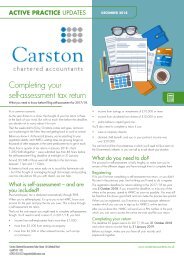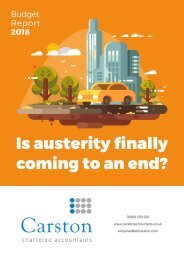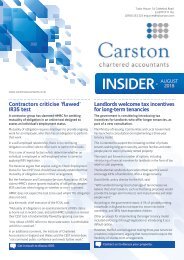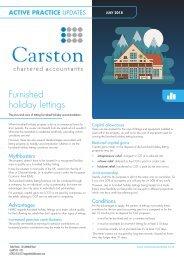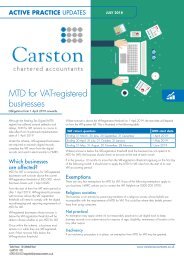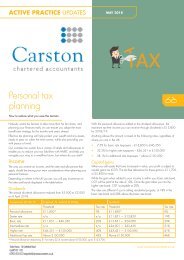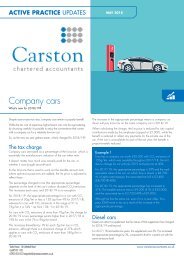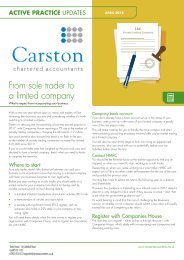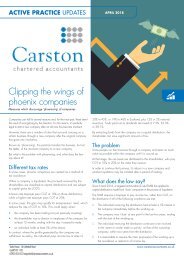The marriage allowance explained.
You also want an ePaper? Increase the reach of your titles
YUMPU automatically turns print PDFs into web optimized ePapers that Google loves.
<strong>The</strong> <strong>marriage</strong> <strong>allowance</strong> <strong>explained</strong><br />
Separation and divorce<br />
If you and your spouse or civil partner separate between the end of<br />
a tax year and the date your tax return is due, there’s a slight chance<br />
you’ll lose your eligibility for the <strong>marriage</strong> <strong>allowance</strong>.<br />
Cancelling the <strong>marriage</strong> <strong>allowance</strong> normally takes effect from the next tax<br />
year unless the <strong>marriage</strong> or civil partnership has come to an end through:<br />
• divorce (decree absolute)<br />
• order of judicial separation<br />
• decree of nullity<br />
• in the case of a civil partnership, a dissolution order, order of<br />
nullity or order of separation.<br />
In these circumstances, the withdrawal of the <strong>marriage</strong> <strong>allowance</strong> can<br />
be backdated to the start of the tax year.<br />
Death of a partner<br />
If a spouse or civil partner dies, it’s possible to make a backdated<br />
claim for the <strong>marriage</strong> <strong>allowance</strong> providing the deceased spouse or<br />
civil partner was eligible for it when they were alive.<br />
A claim can be made for any tax year in which you were both<br />
alive, including the tax year of death, although no claim can be<br />
made thereafter.<br />
How does it work?<br />
Working part-time<br />
Tom’s on an annual salary of £16,000 and is married to Isobel, who<br />
works part-time and earns £5,000 a year.<br />
Isobel elects to reduce her personal <strong>allowance</strong>, which is transferred<br />
when Tom claims the <strong>marriage</strong> <strong>allowance</strong>. <strong>The</strong> beneit is 10% of the<br />
personal <strong>allowance</strong> rounded up to the next £10.<br />
Complications<br />
Non-residential spouse<br />
If your spouse or civil partner is a non-UK resident, but hails from the<br />
European Economic Area (EEA), an extra restriction requires the transferee’s<br />
annual income to be less than the personal <strong>allowance</strong>.<br />
Scottish rate of income tax<br />
Scotland introduced additional rates of income tax for 2018/19 that<br />
do not apply anywhere else in the UK, including the intermediate rate of<br />
21% tax on income between £24,001 and £43,430.<br />
Married couples in Scotland can continue to receive the <strong>allowance</strong>, despite<br />
the introduction of these new income tax bands.<br />
<strong>The</strong> only noticeable difference is that the transfer of the <strong>allowance</strong> isn’t<br />
possible for income tax bands that exceed £43,430 in Scotland – despite<br />
the basic-rate threshold in the rest of the UK stretching further to £46,350.<br />
Income from dividends and savings are not liable for the Scottish rate of<br />
income tax, so Westminster’s basic-rate threshold and 20% rate applies.<br />
Brexit<br />
Less than a year before the UK is due to leave the EU an additional<br />
concern surrounds whether or not the UK retains membership of the EEA.<br />
Should the UK withdraw from the EEA, the <strong>marriage</strong> <strong>allowance</strong> may be<br />
made redundant if your spouse or civil partner comes from an EEA nation.<br />
<strong>The</strong> EEA countries comprise all 28 member states of the EU plus<br />
Liechtenstein, Norway and Iceland.<br />
Get in touch to discuss the <strong>marriage</strong> <strong>allowance</strong>.<br />
So the transferable amount is £1,190 in 2018/19, giving a tax<br />
saving of £238. This transfer does not impact on Tom’s national<br />
insurance contributions.<br />
Dividends income<br />
Dicky is a director who pays himself an annual salary of £8,000 and<br />
receives a dividend payment of £30,000. His spouse, Katie, earns<br />
£10,000 a year.<br />
Katie elects to reduce her personal <strong>allowance</strong>, enabling Dicky to submit a<br />
claim and increase his personal <strong>allowance</strong> by £1,190.<br />
As Dicky’s dividend income is taxed at 7.5%, the tax saved is £1,190 x<br />
7.5% = £89.25.



